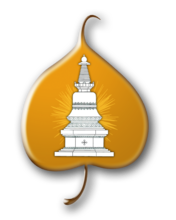Kadampa Stupa Characteristics

![]()
Kadampa stupas differ from other stupas in their form. Although they possess the same underlying elements as other stupas, these elements take on a distinctive form and arrangement.
The most recognizable feature of this stupa is its overall bell-like shape. It also includes a row of doubled lotus petals along the base, a stepped harmika, a conical arrangement of thirteen bhumis surrounding the central axis, and a lotus-form top piece.
This form has its roots in ancient India. It is based on a stupa brought to Tibet by Lama Atisha, the great teacher of the second propagation of the Buddhist doctrine in Tibet. Whenever Lama Atisha traveled in Tibet, he carried a wooden stupa of this style with him for his spiritual support. The stupa serves as one of his distinctive attributes. One who practices in the tradition of Lama Atisha is called a "Kadampa," the tradition of practice estalished by Lama Atisha's heart disciple, Dromtonpa. The stupa of the style used by Lama Atisha is thus closely linked to the Kadam sect, as is reflected in the name, Incidentally, relics of both Lama Atisha and Dromtonpa are enshrined within large Kadampa stupas at the Neton Drolma Lhakhang monastery, the site of Lama Atisha's death in 1054, located just outside of Lhasa, Tibet.



